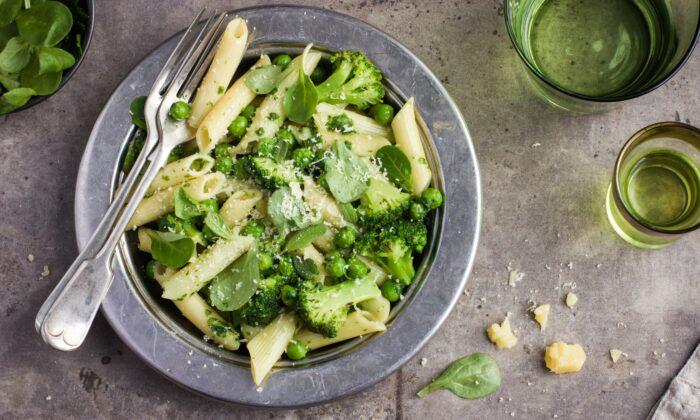Apr. 18—Lottie Bildirici learned the hard way that it’s not enough to train and have goals to become a better runner. What you eat before and after workouts also has a dramatic impact on your body’s health and endurance.
After taking up running in her senior year of high school, following a bout with cancer, the Brooklyn native entered a string of races. She got serious about the sport almost immediately and, in an effort to boost performance, became obsessed with eating only “healthy” foods. Yet rather than propel her new heights, the restrictive diet ended up backfiring.
The more pure her diet became, the more her young body broke down with multiple stress fractures.
Realizing she was on the wrong path, Bildirici — a baker and vegetarian since age 17 — decided to take a more mindful approach to her “so-called health obsession” as she entered college. She would view food not either as good or bad, but as fuel.
As she notes in her new cookbook “Running on Veggies” (Rodale, $25.99), the turnabout took significant effort, but restrictive eating eventually became intuitive eating, focused on nutrient-dense whole foods and lots of vegetables. “I was determined to make it to the other side, emerge with a healthy body and mind,” she writes.
From Cancer Patient To Nutrition Coach
Readers also learn the story of how the 27-year-old New York City resident found healing through running and food after being diagnosed at age 14 with Stage III Hodgkin’s Lymphoma. Though she was safely in remission by her senior year, she still felt the stigma of being known as the sick girl. It was only after running a 5K to raise money for a local cancer charity that she finally felt completely healed. “On that starting line, I felt powerful, in control of my life, like I hadn’t before cancer,” she writes.Years in the making, the book was born of the Instagram account and blog of the same name she started in 2013 to connect with other runners of the same mindset. A communications student at Fashion Institute of Technology at the time, she'd fallen down the rabbit hole of sports nutrition books, and wanted to share.
As she explains on a call from her apartment in New York City, “I wanted to understand the ‘why’ behind everything I was eating.”
Endurance athletes, especially females, had little guidance on food and nutrition at the time. To help other runners achieve their nutritional and athletic goals, she logged what she ate pre- and post-workout, along with simple recipes that her followers could make at home.
What she didn’t expect was that professional runners like Kara Goucher would soon be among her biggest fans.
Bildirici was sitting in her college cafeteria 10 years ago when the Olympian first made a comment on one of her posts. She recalls taking a screenshot. “It was insane!” she says. “I just loved everything she embodied.”
Not long after, Goucher asked if she would do a cooking demo and talk nutrition at an upcoming runners’ retreat in Napa, California. Bildirici, who at the time was studying to become a holistic health coach at the Institute of Integrative Nutrition in Manhattan, of course said yes, even if she felt somewhat intimidated.
“She told me that she liked how I made healthy eating approachable,” she says.
The experience, Bildirici says, was life-changing. “I never felt more at peace in my life.”
In 2015, Goucher invited her to speak at a second retreat in Colorado, and oh, by the way, would she also be willing to come early and cook for her? Bildirici ended up not only staying in Boulder but also cooking for her mentor leading up to the Olympic Trials in Los Angeles in February 2016.
“It was scary but a great opportunity,” Bildirici says. “So I gave it my all.”
That led to more opportunities with other Olympians, world champions and other professional athletes. In 2018, with her initial college dream of working in the music industry a distant memory, she became the North American Nutrition Coach for the Adidas Runners community, offering one-on-one nutrition counseling for runners. She was 24.
On a cold and rainy day that October, to mark 10 years since her cancer diagnosis, she also completed an Ironman competition in Louisville, Kentucky, to raise thousands for the Leukemia & Lymphoma Society.
Keeping It Simple
With her star rising, Penguin Books reached out to see if she wanted to do a book. Feeling she had all the right people in her corner, including world-class runners Colleen Quigley and Emma Coburn in addition to Goucher, she said yes. When she started writing it in 2020, the pandemic made it easy for her to meet deadlines, as well as experiment in the kitchen with new recipes.Putting pen to paper in such an evergreen fashion, she says, also afforded her the opportunity to share her cancer story more widely for the first time, “without crying all the time.”
“So many people have gone through something like this,” she says. “And when I was sick, I just wish I had someone to look up to.”
While nutrient-rich vegetables play a starring role in her cookbook, Bildirici says “Running with Veggies” focuses not so much on what’s healthy or unhealthy but on the importance of whole foods in addition to plenty of veggies. She also is a huge fan of keeping it simple, with recipes that can be prepared quickly using very basic ingredients.
She doesn’t want to spend her entire day in the kitchen and knows you don’t, either. As such, “I’m not going to ask you to head to the specialty health store for teff powder. I know where everyone is coming from. If it’s not easy, you’re not going to cook it.”
Breakfast recipes include one for overnight oats with a mixed berry chia jam that’s perfect for people who are bleary-eyed in the morning, or are traveling to a race but only have access to a hotel mini fridge. You'll also find a gut-healthy brown rice bowl topped with kimchi, avocado and fried egg, and peanut butter and banana pancakes made with oat and almond flours.
For drink lovers, there’s an entire chapter on every runner’s quick-fix beverage — smoothies — but with this added nutritional boost: All include at least one vegetable and a healthy fat like avocado or tahini to balance the flavor and texture.
Packed with mouth-watering photos, the book also serves up more than a dozen grain and noodle bowls enhanced with nuts, spices and sauces, and almost as many “plates” — a category that includes everything from tacos to vegan meatloaf to veggie burgers and even a couple of fish dishes.
Because all work and no play is no fun, the cookbook also includes portable “adventure snacks” you can stick in your backpack to fuel all different kinds of activities — think bars, trail mix and no-cook date bites. Her plant-based desserts are made with natural sweeteners like maple syrup and dates, which can help runners replace their glycemic stores after a workout.
All, Bildirici says, reflect what you might find in her kitchen or on her dinner table on any given night. It’s also representative of how she cooks for her athlete clients, “and even when I’m having people over for dinner,” she says.
And if you’re not particularly athletic? The book is for you, too, because good nutrition isn’t just for runners and other athletes. It plays an important role in everyone’s lives.
“It’s for anyone who wants to get in the kitchen and eat a little healthier,” she says, even if you don’t follow the recipes to a T.
People are always looking for that magic superfood, Bildirici says, but it’s really about a holistic lifestyle. Part of that is changing the way you think about food and your relationship with it.
Almond Berry Overnight Oats
PG testedOnce you make the berry jam, this carbohydrate-rich recipe takes a minute to prepare for the next morning. Soaking the oats overnight makes them easier to digest, because it helps break down their natural enzymes. I used unsweetened almond milk and a combination of raspberries and blueberries for the jam.
Prepare jam: In a small saucepan, combine berries, lemon zest and juice, orange zest and juice and chia seeds. Add water and bring to boil. Reduce heat and allow to simmer for 20 minutes, stirring frequently.
Remove from heat and mash fruit with a potato masher or wooden spoon. Allow to cool for 20 minutes, or until mixture is thickened. Store in an airtight container in fridge for up to one week.
Prepare oats: In a small saucepan, heat nut milk until simmering. Meanwhile, place 2 tablespoons jam in a pint-size mason jar.
Top with oats, chia seeds, cinnamon, vanilla and salt. Pour warm milk over the top and stir to combine. Cover with a lid and place in the refrigerator overnight.
Before serving, stir the oat mixture again, then top with almond butter, fresh berries and toasted almonds.
Supergreen Pasta
PG testedPasta is a favorite dish for runners because it’s a good source of carbohydrates. This recipe swaps traditional wheat pasta for penne made from brown rice. Instead of tomato sauce, it’s topped with a fresh-tasting chimichurri-like green sauce. It’s fantastic.
To make almond Parmesan, blend 1/2 cup raw almonds, 1/2 teaspoon salt, 2 tablespoons nutritional yeast and 1/2 teaspoon garlic powder in mini food processor until finely ground.
Make sauce: In the carafe of a high-speed blender, blend spinach, garlic, walnuts, herbs, olive oil, vinegar and water until well combined. Season with salt and pepper, then set aside.
Preheat oven to 400 degrees.
Bring a large pot of salted water to a boil, add the pasta and cook for 2 minutes less than the package instructions advise.
Meanwhile, line a rimmed baking sheet with parchment paper. On the prepared baking sheet, toss the broccoli with avocado oil and season with salt and pepper. Roast for 15 minutes, tossing halfway through, until golden brown and crisp-tender. When finished roasting, remove broccoli from oven and allow to cool slightly.
Drain pasta, lightly rinse and transfer to a large bowl. Add the green sauce, roasted broccoli and baby spinach to the pasta and toss together. Garnish with chopped mint, parsley and cilantro, and sprinkle with almond Parmesan, if using.
Chili-Spiced Salmon With Mango Salsa
PG testedProfessional runner Kara Goucher contributed this family-favorite recipe for salmon. “It fuels my body with good protein and lots of healthy fats,” she writes, making it an excellent dinner choice after a hard workout session. The mango salsa is also terrific with tortilla chips.
Make salsa: In medium bowl, combine mango, onion, bell pepper, jalapeño, cilantro and lime juice. Season with salt and set aside to marinate while you prepare the fish. Preheat oven to 400 degrees. Line a baking sheet with parchment paper.
In small bowl, mix together garlic powder, onion powder, paprika, chili powder, cumin and salt.
Place filets on the prepared baking sheet and sprinkle each one with the spice rub. Bake for 15 to 20 minutes on the middle rack, or until fish is opaque, cooked through and flakes easily with a fork.
Place filets on a serving platter and top with mango salsa. Serve with coconut rice.
Serves 4.






